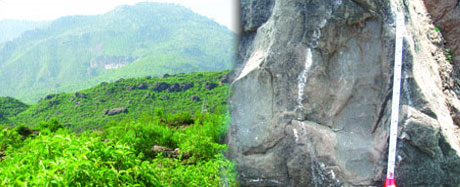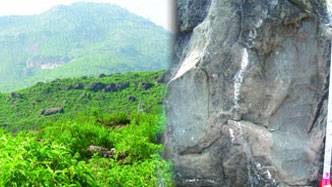1m-years-old footprints found at Margalla Hills
Source: dawn.com

Islamabad, July 27: In what appears to be a major discovery, archaeologists have found two over one million years old human footprints preserved on a sandstone at the Margalla Hills.
The Indusians Research Cell, which is working under the supervision of world renowned archaeologist and historian Dr Ahmad Hassan Dani of Taxila Institute of Asian Civilisations, Quaid-i-Azam University, Islamabad, has made the discovery, which is likely to add a new chapter to the archaeological history and heritage of the federal capital and attract visitors.
A footprint of 1 feet is in complete and well preserved form while another is broken from the finger side which is also of the same size in comparative manner. The notable marks of the feet are the clear veins and opposite folded appearance.
“A huge stone on the top of the hill is the secure home of these prints since about over one million years ago,” says A.K. Azad, an archaeologist and head of the project.
Further research may give more clues of the foot marks through anthropological and geophysical methods, he observed.
The recent discovery is the continuity of the Indusian Research Cell’s earlier research about human evolution which previously revealed a fossilised upper jaw from the site of Dhudhumber, foot and hand prints from Attock and Palaeolithic cave from Margalla hills.
Pakistan’s geomorphologic research was conducted to compare with the Alps of Europe during the period of 1930-1939 by a French mission. Since then, lots of other dimensions of the research opened the doors of scientific research in Pakistan as the country provided the glacial sequence, fossilised evidences of Pre-Cambrian to Holocene epochs, earliest evidences of the anthropoid existence, earliest cultural centre at Mehargarh (contemporary of Jericho and Jarmo) and most advanced civilisation of the world (Indus valley).
Indusians Research Cell started the second phase of the project “Post-earthquake Explorations of Human Remains in Margalla Hills” under the supervision of A.K. Azad.
According to Mr Azad the formation of the Margalla Hills goes back to the Miocene epoch. The dominant limestone of the Margalla is also mixed with the sand stone.
“So we can assume that due to availability of the water in ancient times many marks of the zoological as well botanical significance may lead to our objectives,” the young archaeologist hopes.
In 1976, Pakistan opened another chapter of human evolution, which makes case for Asian anthropoid origin from this region.
During the ‘60s and ‘70s, Pilbeam led expeditions to the Siwalik Hills badlands of northern Pakistan, searching for further Ramapithecine remains.
In March 1975 and January 1976 team members made surface recoveries of four bone fragments which fit together to form the most complete mandible recovered yet. The mandible shows that Ramapithecus did not have a parabolic, human like dental arcade, as originally thought, but rather a V-shaped, more apelike arcade. Though the shape of the arcade is not now regarded as one of the more anatomically important characters, Ramapithecus is no longer granted the high status that it once received.
Different scholars have defined the word ‘Potohar’ differently. But, anthropological research marked it, as the grand father of hominid, also known as Punjabicus found from the Potohar region.
So the government of Pakistan had given the name to this specie Potoharmans.
According to Mr Azad, the problem of human evolution is still hanging around that when and where Anthropoid got physical changes from the Apes?
After India, Kenya and China, he says important discovery was from the Potohar region from fossils of the similar species found in 1976 and 1982. The probable dating given to this specie was 20 million years.
“It has provided a missing link, which was spread of 6 million years. So Potoharmans declared as the grand father of hominid, which evolved from the different stages and reached at the Homo sapiens,” he observes.
The stories behind the similar marks are also significant in mythical associations with saints and renowned people i.e. hand prints of the Baba Guru Nanik near Hassanabdal, foot prints of Hazrat Ali in Hyderabad, foot prints of the Guru Padma Sambhava (Second reincarnation of Buddha) in Swat, Adam’s peak of Sri Lanka etc.
“If these are true than we can also claim of the mother Eve’s foot prints from Margalla Hills,” Mr Azad observed.
Article from: http://www.dawn.com/2007/07/28/nat3.htm






















